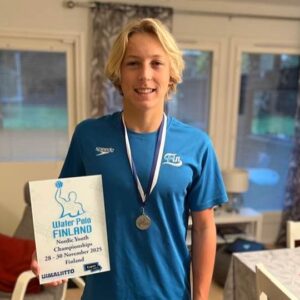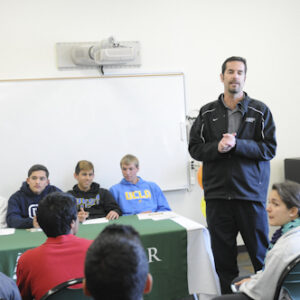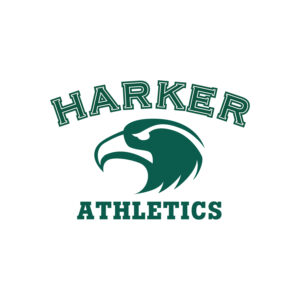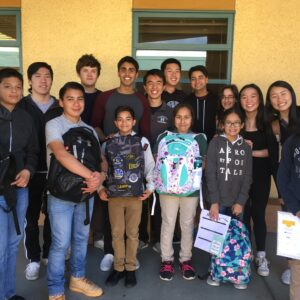By Jason Berry
This article was originally published in the spring 2013 Harker Quarterly.
The first Wednesday of February probably does not call for much attention or register as an important day in the minds of most students lugging backpacks from class to class, but for five members of the Class of 2013, that date, Feb. 6, meant that courtship between school and player was over, and they could take pens in hand to sign their letters of intent to play collegiate athletics for their chosen universities; an additional student signed earlier in the year.
After a few sullen days of rain in early February, Harker found itself awash under a baby blue sky. As students made their way to lockers in the morning to gather their books and anthologies, video monitors in the main academic hallway glowed with the day’s news. One special announcement caught the attention of many a passerby: an invitation from Dan Molin, athletic director, to join seniors Michael Amick, Siobhan Cox, Karan Das-Grande, Ashley Del Alto and Andy Perez in the college counseling offices as they signed to commit themselves to four years of college athletics, joining Maverick McNealy, who in November signed as a Stanford linksman.
In recent years, national signing day has grown in popularity and prominence, due, in part, to the surge in ESPN and regional markets that cater to specific conferences like the Big 10 and Southeastern Conference. Star-studded football recruits hold a nation’s attention, and fans bite their lips as they watch a fabled recruit extend his hand to clasp their school’s hat. A top athlete choosing the maize and blue of Michigan sends jubilant cheers through Ann Arbor and beyond, while in Columbus, Ohio, the Buckeye denizens sigh woefully at missing out. Just such a scene is by no means a hyperbolic one, and as other sports gain popularity, football recruits will not be the only ones holding press conferences.
Michael Amick will be playing soccer for UCLA. A Harker Eagle since kindergarten, Amick began dribbling a soccer ball at age two when he enrolled in Kidz Love Soccer, an instructional youth camp. From those early beginnings, Amick began to develop a keen awareness for the game, and after dabbling in track, he decided that “the joy of soccer” and team aspect of the game far outweighed the individualism of track and field.
As Amick matured over the years, so, too, did his game. His field awareness, precision passing, speed of play and sheer athletic prowess led him to be selected for premier club teams, and his time with the De Anza Force and coach Shaun Tsakaris (who is also the varsity boys coach at Harker) sent his stock soaring.
Over the past four years, Amick has concentrated his efforts on “pushing [himself] harder and harder each and every day,” he noted.
This mental fortitude found promise in January 2012 when Amick was called up to the U18 national team and scored two goals in international competition. Attending and playing for the same school as other soccer greats like Carlos Bocanegra, Brad Friedel and Jonathan Bornstein do not faze Amick; rather, he embraces the challenge an elite soccer university offers, stating, “There is a time and a place to be social and joke around, but when it is time to put in the work, the mindset must be right.”
Siobhan Cox has been working that mindset for her club team PSVUnionFC, which stands for Peninsula Silicon Valley Union Football Club, and, as a result, will be playing soccer for Stanford. Cox began showing interest in soccer around age 7 and has been embracing the sport for the past nine years.
Her club team “trains every day, which is unusual for a club environment,” she said, but the competitive nature of those sessions has brought about “fun and intensity.”
While Cox played her freshman year only for Harker, she relishes that season and credits the graduating seniors from that year as the catalysts for motivating her to play soccer. Attending a rigidly academic school, Cox recognizes the credit that is due her teachers. She states, “Harker has provided me with the opportunity to take care of the academic side, especially as many people don’t realize that athletes who want to go to a highly academic school must also meet the academic requirements, regardless of their [athletic skill].”
While Stanford will be her home for the next four years, Ireland, England and the United States may be calling upon her skill in later years. With a mother from Ireland, a father from England and the United States as home, Cox “is available to play for three different national teams.” She now just needs to bide her time until July 27 to start training with the Cardinal, but her name is already on the press release and signing made it officially a “dream come true,” she said.
The only one to leave California, Karan Das-Grande will make his way across the country to Connecticut College to submerge himself in water polo. A Harker student since grade 1, Das-Grande’s introduction to the sport was a late one, but he has been making waves, and schools took notice. While the sport is, arguably, still more regional than national, water polo saw tremendous exposure during the 2012 Olympics, and Das-Grande sought a college whose program was “young and on the rise.”
Connecticut College met both criteria and is also a liberal arts school, a final requirement of his. Claiming that “defying the odds is possible,” Das-Grande points to his sophomore year and his contest against Saratoga as a defining moment for him both as a player and as an individual. Despite losing to Saratoga twice in the regular season, Harker “managed to squeak out a 7-6 win in league finals,” Das-Grande said. As a result, some of the Saratoga players refused to exchange handshakes during the contest overtures. Accordingly, Das-Grande remarked that “given their frustration, [the victory] taste[d] even better.” Having been coached and taught by “role models,” Das-Grande is grateful for the help he has had in growing into a mature, respectful person.
On the diamond, softball player Ashley Del Alto will be taking her bat and glove to Iowa to pursue her dreams at Briar Cliff University. Daughter of J.R. Del Alto, the Saratoga campus’ maintenance director, she will abide by the words of her new head coach Michelle Schaper: “If you produce, you will play.” And Del Alto is no stranger to producing. As a four-year varsity athlete on the softball team, she raised her batting average from an already-impressive .371 percentage as a freshman to an astounding .537 as a junior; she also has 34 RBIs. A two-time first team all-league player, Del Alto will need to adjust to the climate in Iowa, but she states that “the care of the Harker community and the knowledge gained from her teachers” will help her transition to the “tightly knit community of Briar Cliff.” As Del Alto charges on to the field at Briar Cliff she takes with her memories of 14 years at Harker, remarking that she “would not want to be a part of any other class.”
Recognized as the next rising talent in the world of golf, Maverick McNealy will be playing for Stanford. As the son of parents who both share an infinite love of solving problems, McNealy sees tranquility in what many consider to be a frustrating game.
Learning the game when he was learning how to walk, he “loved to go outside and whack balls around with a plastic club,” he said. Arriving at Harker in grade 9, McNealy immediately excelled on the links, but he believes that “until [he] shoot[s] 18 in every round of golf he plays, there will always be room to get better.”
Given that drive, it is no wonder that McNealy is acutely aware of the life lessons golf provides: “Golf, to me, is the ultimate game of personal responsibility,” he said. “Your performance is a direct result of the time and effort you put into the game, and you take complete responsibility for your play. If you hit a bad shot, you can only blame yourself because you were the only one to swing the club. Conversely, if you make a hole in one, you can take complete pride in your accomplishment.”
Even attending Stanford, home to Tiger Woods and Tom Watson, McNealy’s “favorite golfer,” causes no anxiety, and he credits Harker for that aplomb. “Everyone whom I have met (at Harker) is motivated and possesses a great work ethic,” he said.
Andy Perez also had an early commitment to soccer: he played it in his crib, he said, and when fall arrives, he will be taking the field for the University of California, Santa Barbara. Perez credits parents for ingraining in him a solid work ethic. Perez’ father, Ismael, a professional player for the San Jose Earthquakes, “coached [his son] at the age of four and continuously pushed him to strive harder.”
Perez began attending Harker in grade 4, and when he arrived on the Saratoga campus for his freshman year, he played for Tsakaris and thought that the “camaraderie with teammates who are also classmates is an advantage because you want to work hard for your friends,” he said.
Moving over to the De Anza Force as well as the San Jose Earthquake’s Academy team proved invaluable for Perez, especially in terms of gaining national recognition. He does recognize that Harker has played a vital role in his academic growth and also helped to instill in him the character trait of respect.
One instance in particular that stands out for Perez is a playoff game between Menlo and Harker during his freshman year. He reminisced: “Halfway through the game I looked over at the fans and saw a sea of Harker fans, students, faculty, football players, basketball players, and many more coming together to root us on to the next round. We ended up losing the game, and that was our last game with the seniors, but after the game all the fans came up and congratulated us on a great season.” It is in this spirit of respect and passion and pride for high school that Perez makes his way to become a Gaucho.









